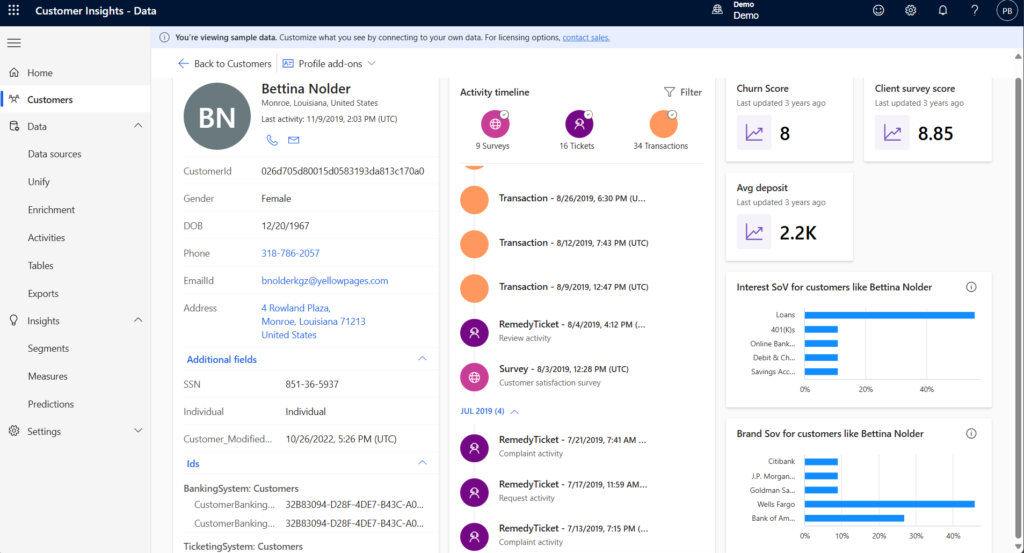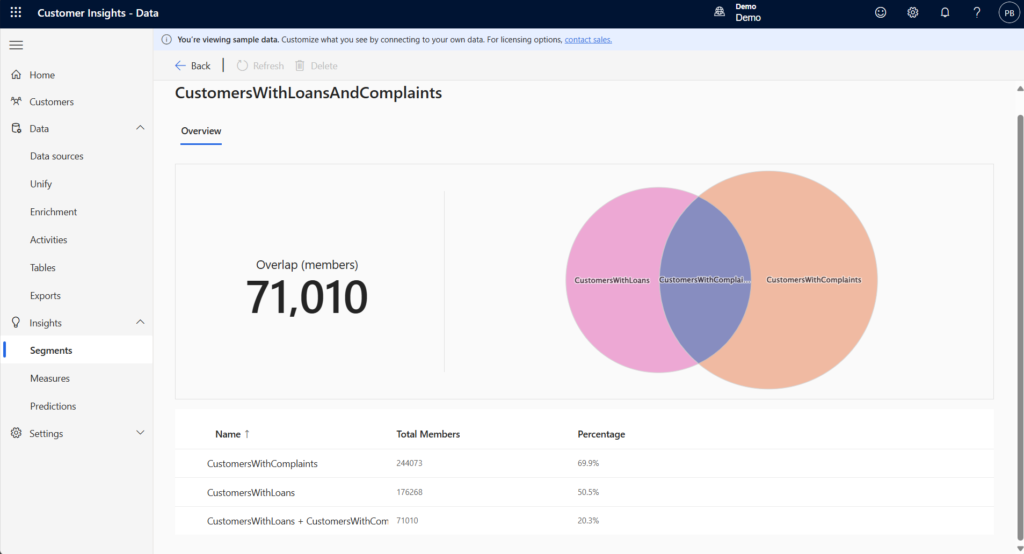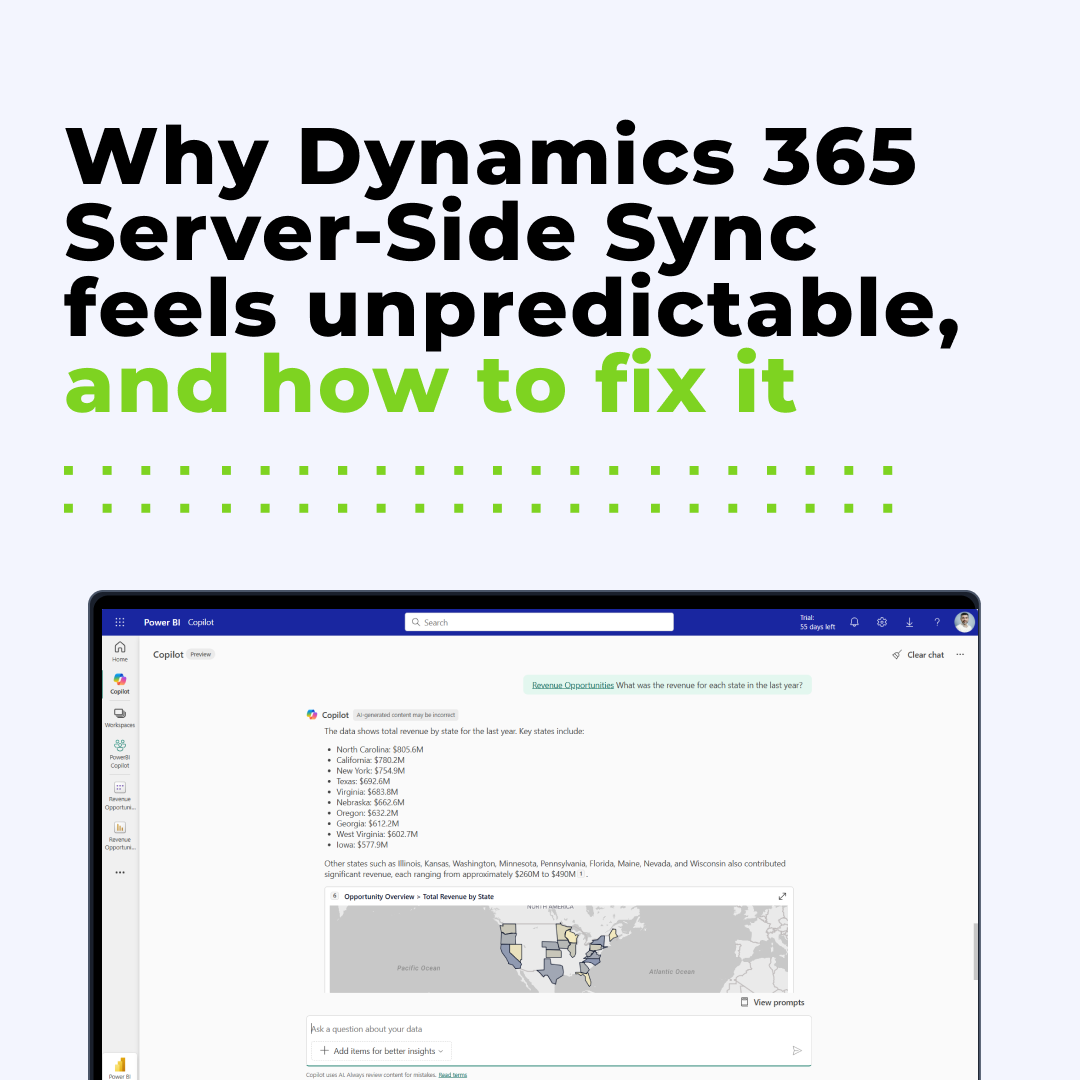Home » How Customer Data Platforms support a unified customer view
How Customer Data Platforms support a unified customer view
Gaining a unified customer view
Both Customer 360° and CDP help us get a single, comprehensive view of our customers.
Customer 360° is the outcome we’re aiming for: a complete profile of a customer that brings together all their relevant data into one place.
Customer Data Platform (CDP) is the underlying technology that makes this single view possible. It’s the system that collects, cleans, organizes, and unifies all that customer data.
In the simplest terms, the CDP is the tool that builds the Customer 360° outcome. It helps us personalize experiences and make smarter, data-driven decisions across all our teams – marketing, sales, service, and product.

What kinds of data does a CDP solution use?
Transactional data
This type of data describes what the customer buys or how they spend. For example, this can include:
- purchase history, order value and frequency
- cart additions and abandonments
- subscriptions
- refunds or returns
- loyalty points and coupon redemptions.
The sources of this data include Point-of-Sale (PoS) systems, order management systems, and e-commerce platforms.
Behavioral data
This type of information is about what users do and their activities in digital spaces. Example data include:
- website visits and clicks
- product views
- on-site search queries
- form submissions
- email opens and clicks
- app usage patterns
We can gather this information from websites, mobile apps, emails, cookies, or analytics tools.
Interaction and engagement data
This data type captures how customers interact with our brand across different channels. Here, we analyze:
- reviews and ratings
- survey responses
- social media messages and mentions
- customer service tickets
- call center transcripts
- chatbot conversations
This information is usually gathered from CRM systems, call center platforms, support tools, and social listening tools.
Demographic data
Demographic data help us understand who our customers are. Depending on the use case, this can include information such as:
- name
- age
- gender
- location
- email address
- phone number
- company
- job title
- language preference
and other details.
Contextual, environmental, and identity data
There is a lot of additional information we can gather to add real-time context to customer interactions. We can also use it to match data to a particular user across multiple channels. This additional data can include:
- real-time location
- device
- browser
- device ID
- username
- cookies and session IDs
- loyalty card numbers
- social media handles
All these different types of information are essential for improving how we engage with both new and existing customers. But when this valuable data is stuck (siloed) in separate systems, it is difficult to get a clear picture of who our customers really are, what they’re doing, and what they expect.
A CDP solves this by breaking down these data walls. By unifying diverse sources into a single, enriched, and accessible profile, it allows us to deliver personalized and timely customer experiences that truly resonate.
The functionalities of a Customer Data Platform
Personalization at scale
Powering experiences with real-time data
Dynamic customer segmentation
A modern Customer Data Platform enables a more dynamic, precise, and actionable segmentation. Customer groups are automatically updated based on real-time activity and data from multiple sources. For example, a customer might automatically move from a “prospect” to a “high-value repeat buyer” segment after their second purchase.
In addition, many modern CDPs include built-in AI and machine learning capabilities to support predictive segmentation. This lets us group customers by what they’re likely to do next, such as their probability of converting, churn risk, predicted customer lifetime value (CLV), or interest in a particular product category.
Not just for marketing
The benefits of customer segmentation go way beyond marketing. All our customer-facing teams – sales, support, and product – can access and use this rich data:
- Sales can prioritize leads from high-value segments.
- Support teams can tailor their service approach based on customer tiers.
- Product teams can personalize in-app experiences based on behavioral segments.
Next-gen analytics with AI
Many CDPs now come with integrated analytics and AI capabilities, offering predictive customer insights like churn risk, customer lifetime value, or even determining the next-best action.
A modern CDP turns the data it collects into a powerful training ground for AI/ML models. These models can uncover hidden patterns, score customer behavior and value, and generate actionable predictions.
This means that, instead of just looking at past activities, we can anticipate what customers are likely to do next and adjust our strategies accordingly. This can directly impact our business performance by:
- Improving campaign ROI by targeting the right customers with the right message at the right time.
- Reducing churn by identifying and engaging at-risk customers early.
- Increasing conversion rates by aligning offers with customer intent.
- Enhancing customer satisfaction by delivering more relevant, timely, and personalized experiences.
- Optimizing resource allocation by focusing efforts where they’ll have the biggest impact.
Next-gen customer strategy with Dynamics 365 Customer Insights – Data
Dynamics 365 Customer Insights – Data is a CDP solution from Microsoft. It is built to create a single source of truth for your customer data and offers a comprehensive set of features, such as:
- Connecting to a wide range of data sources (CRM, ERP, web, social, IoT, etc.),
- Merging customer data using identity resolution and matching,
- Building unified customer profiles (Customer 360),
- Creating dynamic customer segments based on behavior, demographics, and more.
Dynamics 365 Customer Insights – Data easily connects with other Microsoft services like Power Platform and Dynamics 365, plus many other solutions, making it a flexible choice for most tech stacks. It also has powerful, built-in AI capabilities for insights, predictions, and data enrichment.

Example of a unified profile that brings together transactions, tickets, surveys and predictive insights in one place. This empowers every team – from service to product – with real-time, contextual understanding.

Dynamics 365 Customer Insights – Data identifies and visualized overlaps between customer groups (e.g. customers with loans and complaints), enabling dynaminc, real-time segmentation.
Integrated AI capabilities
Dynamics 365 Customer Insights – Data comes with powerful built-in AI capabilities powered by Azure Machine Learning and Dynamics 365.
Auto-generated insights
Custom models
AI-powered enrichment
Native integration
Take customer experiences to the next level
If you’re looking to provide better customer experiences, a Customer Data Platform could be just the right move. It lets you get the most out of the data you already have and use it to give your audience exactly what they need at exactly the right time.
If you’re not sure where to start or want to learn more about CDPs or Customer Insights – Data, feel free to reach out. I’d be happy to explore how it can support your business.

Unlock smarter customer insights
See how we turn your data into action with Microsoft Customer Insights.
See the latest insights from Netwise
Let AI Agents send follow-ups and close cases automatically
Learn how variables enhance AI Agent interactions and see how different variable and data types work in Copilot Studio.
Read moreWhy Dynamics 365 Server-Side Sync feels unpredictable – and how to fix it
Why Dynamics 365 Server-Side Sync feels unpredictable — and how to make it consistent, transparent, and user-friendly again.
Read more15 years at Netwise: a conversation with our Chief Delivery Officer
In this article, you’ll learn about Adrian Wieczorek’s journey from developer to Chief Delivery Officer and how Netwise has evolved over the past 15 years.
Read more

